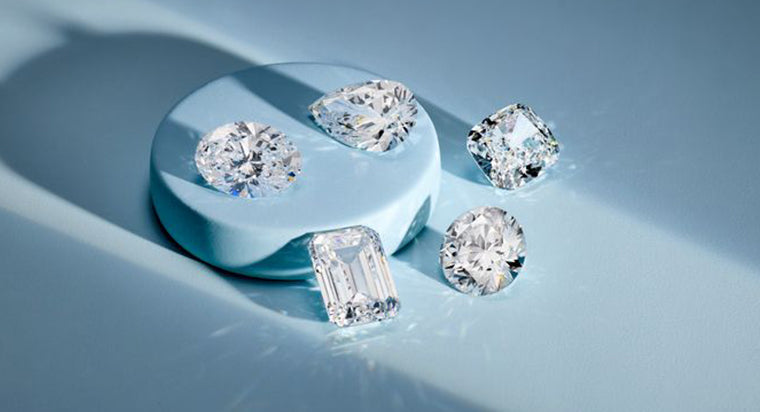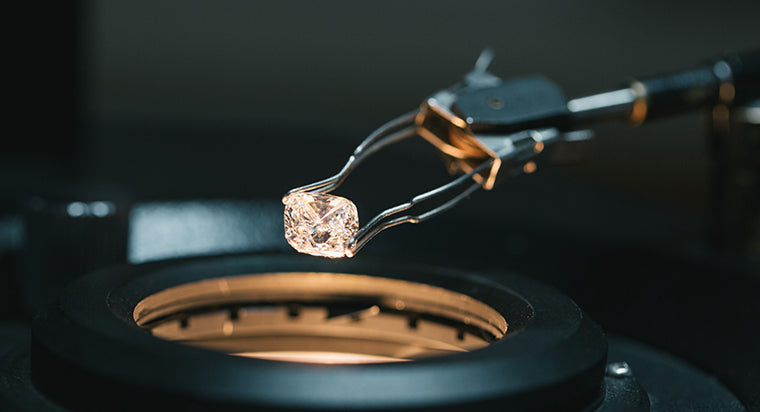VS1 vs VS2: What's the Actual Difference Between These Clarity Grades?

Irony of ironies: At face value, clarity can be the most confusing aspect of buying a diamond. Of the four C's — cut, color and carat are the others — clarity has the most complicated nomenclature. There are eight clarity grades, including FL, IF, VVS1, VVS2, VS1, VS2, SI1, SI2, and I1. But insiders know you only really need to keep two letters in mind: VS.
Clarity refers to the visibility of imperfections that occur naturally during the diamond’s growth. The clarity scale ranges from noticeable imperfections (also known as inclusions) to seemingly flawless, even under magnification. VS diamonds, or very slightly included diamonds, have small imperfections that are difficult to see under 10 times magnification and almost impossible to see with the naked eye.
TABLE OF CONTENTS
Why VS Diamonds are a Good Choice
VS diamonds have two grades:
VS1 (very slightly included 1)
VS2 (very slightly included 2)
Firstly, a VS1 diamond has fewer and smaller inclusions than a VS2.
Average Lab Diamond Cost
Based off of the most popular shape, color, and clarity.
| Cut | Color | Clarity | Average Carat Weight | Average Price |
|---|---|---|---|---|
| Round | G | VS 1 | 1.03 | $1,510 |
| Princess | G | VS 1 | 1.02 | $1,590 |
| Oval | G | VS 1 | 1.03 | $1,730 |
| Emerald | G | VS 1 | 1.04 | $1,333 |
| Pear | G | VS 1 | 1.03 | $1,550 |
| Radiant | G | VS 1 | 1.02 | $1,642 |
| Cushion | G | VS 1 | 1.02 | $2,638 |
| Marquise | G | VS 1 | 1.03 | $1,875 |
(We offer lab grown diamonds ranging from 0.5 to 2.5 carats.)
Because VS diamonds rank just below VVS2 (very, very slightly included 2), they are of high quality — remember, any VS inclusions are difficult to see with the naked eye — and therefore good value if you're trying to figure out how to buy an engagement ring on a budget. Only 20 percent of diamonds are grade VS2 and above, and a VS diamond can cost 10 to 20 percent less than a VVS.

To the naked eye, a VS diamond's sparkle is unimpeded by large inclusions, and light performance is high. There are no structural problems that would cause chips or cracks in the diamond when set in jewelry. Although a VS diamond isn't flawless, it’s very respectable and valuable — VS diamonds appreciate in value over time because of their rarity.
Over time, consumer preference has shifted away from sheer carat weight and more toward quality. When budgeting the 4 C’s, you can feel comfortable about choosing a clarity in the VS2 or VS1 range.
VS1 vs VS2: What's the Difference?
A VS1 diamond is a high clarity grade with no visible inclusions and only small, hard-to-identify inclusions under 10x magnification. These diamonds represent the top 5 percent of all gem-quality stones. The most common VS1 inclusions are crystal (white or black), feather, indented natural, knot, or needle.
Whereas a VS2 diamond will have eye-visible inclusions only 5 percent or less of the time, and only in larger diamonds above 1 carat. Common VS2 inclusions are crystal (white or black), feather, indented natural, knot, needle or cloud.
Average Lab Diamond Cost
Based off of the most popular shape, color, and clarity.
| Cut | Color | Clarity | Average Carat Weight | Average Price |
|---|---|---|---|---|
| Round | G | VS 2 | 1.04 | $1,657 |
| Princess | G | VS 2 | 1 | $1,323 |
| Oval | G | VS 2 | 1 | $2,300 |
| Emerald | G | VS 2 | 1.03 | $1,132 |
| Pear | G | VS 2 | 1.02 | $1,884 |
| Radiant | G | VS 2 | 1.03 | $1,509 |
| Marquise | G | VS 12 | 1.03 | $1,767 |
(We offer lab grown diamonds ranging from 0.5 to 2.5 carats.)
VS1 vs VS2: Do they Look Different?
Here's a glimpse at what VS1 and VS2 diamonds look like up close.

VS1 vs VS2: How their Prices Stack Up
We generally recommend VS1 diamonds over VS2 when the price differential isn't too great; that's a good way to ensure you're getting maximum value, as VS1 diamonds will appreciate more over time.
Because inclusions are more visible in diamonds with larger, open facets, you should pick VS1 over VS2 when choosing diamonds in shapes other than round (particularly in step-cut diamonds such as emerald-cut or Asscher cut).
Consider VS diamonds with inclusions that are off center, or not directly under the table facet of the diamond. Some of these inclusions can be covered by a strategically-placed prong. And always purchase diamonds that come with Gemological Institution of America (GIA) grading reports, so you can confirm their quality. (That’s the only kind we sell here at With Clarity.) A great-seeming deal is often too good to be true.
Ready to make a selection? All of With Clarity's diamonds are accompanied by GIA reports, and our expert on-staff gemologists can help you make the best selection to work for your budget. Contact us by phone at 1(844)-234-6463 or email at service@withclarity.com. Our Live Chat is available during business hours Monday - Friday 10AM - 6PM ET.
Lab Grown VSI1 Diamonds
Each diamond, whether natural or lab grown has some inclusions. These distinguishing inclusions become an integral feature of the diamond be it clouds, feathers or crystals and can affect the price of the diamond. While some inclusions may not be visible to the naked eye, it is possible that few may manage to make their presence felt. Thus, it is essential to patiently study the diamond you are considering for purchase and take the help of an expert gemologist who can guide you. Some may argue that lab grown diamonds have lesser or no inclusions as compared to a natural diamond, such is not the case. Whether grown under HPHT (High Pressure High Temperature) or with CVD (Chemical Vapor Deposition), there will be some amount of inclusions even under these controlled conditions. This is where a certificate comes into play and gives you all the knowledge about your diamond, even the inclusions.
We believe in offering only certified diamonds to all our clients and thus offer an IGI certificate with VS 1 and VS2 lab grown diamonds and a GIA certificate with the natural diamonds of the same quality.
While talking about VS clarity diamonds too, there are natural as well as lab grown diamonds available. With very slight inclusions (VS), it is impossible to see them below 10x magnification and definitely not visible to the naked eye. This makes VS1 as well as VS 2 a good clarity to buy. Whether natural or lab grown diamonds is all but a matter of preference. As both these diamonds look absolutely the same, the only difference lies in their origin. Natural diamonds are derived from the earth’s mantle while lab diamonds are ‘grown’ inside a lab. The process of then grading the diamonds remains the same.
While looking for a lab grown VS1 diamond, H color, a round shaped 1 carat diamond would cost approximately $800 while a natural variants of the same would be around $3700. If you are to consider a VS2 clarity with the same parameters, the lab grown diamond will be $850 while the natural diamond would ask around $3400.
FAQs
What are VS diamonds?
VS diamonds or 'very slightly included' diamonds have small imperfections that are difficult to see under 10 times magnification and impossible to see with the naked eye.
What does VS mean in diamonds?
One of the eight clarity grades, VS means very slight inclusions are present in the diamond. An important point to note is that just because there are inclusions in the diamonds, it is not necessary that you can see them with the naked eye. The diamond will likely be eye-clean, making it a great purchase.
Are VS diamonds worth it?
Yes, VS diamonds are worth it because this particular diamond’s sparkle is unaffected by large inclusions. Also, the light performance is high, making it a lovely buy. While VS diamonds aren't flawless, it is a valuable grade and these diamonds hold or appreciate in value over time because of their rarity.
What is the best clarity grade for a diamond?
The best and highest clarity grade for a diamond is FL or Flawless. However, diamonds graded that highly for clarity can cost significantly more than lower grades. Be mindful when you are selecting the clarity grade of your budget and remember that once set in a ring, a VS diamond will not show inclusions to the naked eye.









